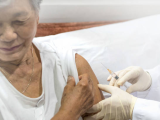Apr 27, 2007 (CIDRAP News) – A committee that reviews medical product applications for the European Union (EU) yesterday recommended approval of a cell-based seasonal influenza vaccine made by Novartis, improving the company's chance of becoming the first to market a flu vaccine grown in cell culture instead of in eggs.
The Committee for Medicinal Products for Human Use (CHMP), which reviews applications for 27 EU countries, found that Novartis's Optaflu vaccine, given to more than 3,400 people during clinical studies, met the CHMP's immunogenicity criteria, the Swiss-based company said in a press release today.
In a statement released yesterday, the CHMP said it concluded there is "a favourable benefit to risk ratio" for Optaflu and therefore recommended its authorization. The vaccine is intended for adults.
The European Commission is not bound by the committee's recommendations but usually follows them, delivering a decision within 2 to 3 months, Novartis said.
If the European Commission approves Optaflu, it may become the first seasonal flu vaccine made with cell-culture production techniques to go on the market. Flu vaccines have been grown in chicken eggs since the 1950s, but several companies are developing processes for growing them in laboratory cell cultures. The Optaflu vaccine is grown in canine kidney cells.
In 2001, the European Commission approved a cell-culture version of Solvay Pharmaceuticals' Influvac flu vaccine for sale in the Netherlands, but the company has not yet marketed it. The company Web site says that market introduction of the vaccine is expected "in the near future."
"Optaflu contributes to meeting the growing demand for seasonal influenza vaccines, and this production technology offers the potential for quick scale-up of manufacturing in the event of an influenza pandemic," said Jörg Reinhardt, chief executive officer of Novartis Vaccines and Diagnostics, in the press release.
Cell-culture production is seen as slightly faster and considerably more flexible than traditional egg-based methods. In its press release, Novartis said products made with cell-culture methods are safe for people who are allergic to eggs because they are not created with egg proteins.
The new technology also offers the possibility of developing vaccine seed strains that more closely match the original "wild" virus, according to Novartis. Cell-culture methods eliminate passage of the virus through eggs, where it may need to adapt before it can replicate. The antigen in a cell-based vaccine may more closely match the wild-type virus and possibly provide a better immune response, the company said.
Novartis has said that Optaflu is a subunit vaccine, meaning it contains individual viral proteins rather than whole virus particles.
In a phase 3 study, conducted in Poland during the 2004-05 flu season, 1,300 volunteers between the ages of 18 and 60 and 1,354 volunteers older than 60 were randomly assigned to receive one dose of either the cell-based vaccine or an egg-based vaccine, according to a previous Novartis report.
Investigators found no differences in the immunogenicity of the vaccines, both of which met CHMP criteria. Local and systemic side effects for the two vaccines were similar in both age-groups.
Novartis said it anticipates applying for US licensing of its cell-based flu vaccine in 2008. The company has conducted phase 1 and 2 clinical trials of the vaccine in the United States and in July 2006 announced it would build a $600 million plant in Holly Springs, N.C., to make cell-culture flu vaccines. In May 2006 the US Department of Health and Human Services awarded Novartis a $220 million contract to develop cell-based flu vaccines, and Novartis has said the money would go toward the cost of the new facility.
Depending on when its vaccine is approved by the Food and Drug Administration, the plant could begin production as early as 2011 and be ready for full production as early as 2012, with an annual output of 50 million doses of a trivalent vaccine, the company has said.
In the event of a flu pandemic, the facility is designed to have the capacity to make up to 150 million monovalent (single strain) doses each year within 6 months of a pandemic declaration, Novartis said. Novartis' other cell-based vaccine production facility is in Marburg, Germany.
See also:
Apr 27 Novartis press release
Oct 24, 2006 CIDRAP News article "Novartis claims success in trial of cell-based flu vaccine"
Jul 18, 2006 CIDRAP News article "Novartis to build US cell-based flu vaccine plant"



















